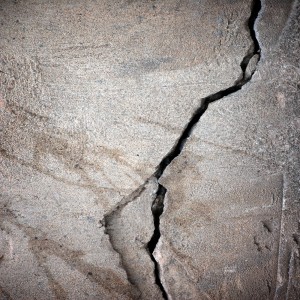Cracks Happen

 Cast-in-place concrete will, more often than not, crack. In a nod to that characteristic, weakened planes (control joints) are formed or cut into conventionally-reinforced concrete slabs and sidewalks to influence where cracks occur. Cracking outside of control joints can indicate shortcomings in concrete placement, finishing, and/or curing, as well as influences from without. Cracks can manifest in a number of forms, most of which are of no structural concern.
Cast-in-place concrete will, more often than not, crack. In a nod to that characteristic, weakened planes (control joints) are formed or cut into conventionally-reinforced concrete slabs and sidewalks to influence where cracks occur. Cracking outside of control joints can indicate shortcomings in concrete placement, finishing, and/or curing, as well as influences from without. Cracks can manifest in a number of forms, most of which are of no structural concern.
Shrinkage cracks are most common and those for which control joints are used. Excessive shrinkage cracks can be caused by high water content in the concrete mix or poor control joint layout.
Plastic-shrinkage cracks are usually shallow and occur when surface water evaporates from the surface of plastic (soft) concrete faster than bleed water from below can replace it. Accelerated evaporation can occur under conditions of low relative humidity, high heat, when wind speeds exceed 5 MPH, or a combination thereof. Plastic shrinkage cracking can be controlled by various methods, including the use of wind breaks, shading provisions, water misting, etc.
Crazing or map-cracking is characterized by interconnected shallow cracks and can be caused by the same conditions that cause simple plastic shrinkage cracks. They can also be caused by poor finishing, particularly on steel-trowel finished concrete. Over-finishing can depress large aggregate and draw excessive paste and fines to the surface. High water content and rapid curing can also produce crazing.
Durability (D)-cracking is caused by the use of porous large aggregates (usually sedimentary materials such as limestone, sandstone, dolomite, shale, etc.) in regions that experience freezing temperatures. It occurs when absorbed water freezes and the resulting expansion (ice occupies about 9% more space than liquid water) breaks the aggregate. The greatest harm is caused by freeze-thaw cycling. The mid-Atlantic region experiences temperatures near the freezing point of fresh water more frequently than most other parts of the country and therefore experiences more freeze-thaw cycles. Deicing agents (such as road salt) creates brines, which have lower freezing points and thereby further increase freeze-thaw cycles.
D-cracking usually occurs near joints and can be partial or full-depth. It will often cause severe spalling and it is considered a terminal, incurable condition.
Displaced or offset cracks are characterized by a height differential on either side of a crack. When they occur at slabs-on-grade, the cause is usually a poorly prepared or unsuitable sub-grade or displacement by tree roots. Significant displacement (one-half-inch, or greater) can present tripping hazards.
Offset cracks in elevated (bridging or cantilevered) slabs could indicate a structural instability. Embedded steel reinforcement would normally prevent displacement and its failure to do so could have serious consequences.
